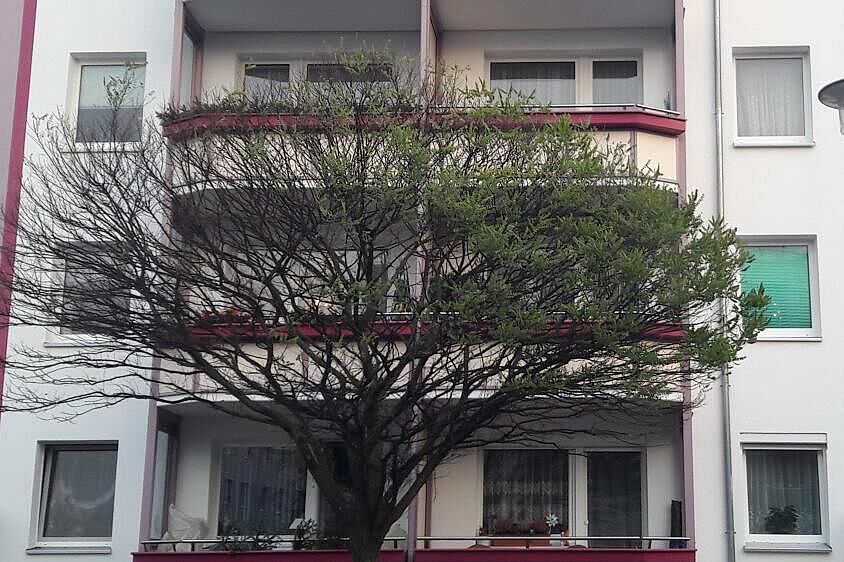Plants have external zeitgebers for their seasonal rhythm. When leaves sprout and fall is largely regulated by temperature and light.

This robinia in Berlin-Friedrichshagen only loses its leaves on one side in autumn. This is due to the lighting from a street lamp, as light is an important timer for the seasonal rhythm of plants. | Photo: Franz Hölker
Chinese, American and German researchers, involving the Leibniz Institute of Freshwater Ecology and Inland Fisheries (IGB), have shown that artificial light, together with urban heat, may be lengthening the growing season in urban environments by as much as 3 weeks compared to rural areas. Light pollution has a greater impact than urban heat, particularly at the end of the growing season. For the study published in Nature Cities, the researchers analysed satellite data from 428 urban centres in the northern hemisphere over a period of seven years.
Rapid urbanisation is leading to hotter and brighter cities. More specifically, buildings and concrete absorb and radiate heat, causing urban heat islands, in which urban areas have higher atmospheric temperatures throughout the day and night compared to their surroundings. Likewise, the amount of artificial light at night, known as light pollution, has also increased by 6-10 percent per year in cities over the last ten years.
Light and temperature largely regulate plant growing seasons. For example, increased lighting and temperature causes trees in cities to bud and flower earlier in the spring and change colour later in the autumn than trees in rural surroundings. However, research has not thoroughly studied the magnitude of their individual or combined impacts on a larger spatial scale.
Berlin, New York City, Paris, Toronto, Beijing - growing season starts and ends around 10 days earlier and later respectively
Lin Meng, a scientist at Vanderbilt University in the US, and her international colleagues analysed satellite observations, taken between 2014 and 2020, of 428 cities in the Northern Hemisphere - including Berlin, Hamburg, New York City, Paris, Toronto and Beijing - and data on night-time artificial lighting, near-surface air temperature and plant growing seasons. The authors found that the wattage of artificial light at night increases exponentially from rural areas towards urban centers. The authors suggest that this increased amount of light appears to influence the start and end of urban growing seasons more than the increase of temperature from rural to urban areas.
Together, both stress factors cause the growing season to start on average 12.6 days earlier and end 11.2 days later in the cities studied than in rural areas. "This can put a strain on the energy and water balance of plants, which also have to contend with water shortages in increasingly dry cities", said IGB researcher Dr Franz Hölker, co-author of the study and the world's leading expert on the ecological effects of light pollution.
Phenomenon will increase further as street lighting is converted to LED
Although these general patterns are consistent across cities in the Northern Hemisphere, the authors also found differences between continents. They observed that the start of the season is earliest in Europe, then Asia, and then North America, although North American cities are the brightest. "Potential causes of this have not yet been investigated in detail. Regional differences in climatic conditions and plant communities, and how they react to environmental stimuli, could be the reason for this," explained Franz Hölker. The effect of light pollution is stronger at the start of the season in some climate zones, including those temperate climates with dry summers and cold climate with no dry season, whereas the effect on the end of the growing season was more consistent across cities.
"We expect the effects of artificial light on the growing season to increase even further in the future. This is because road lighting, for example, is currently being converted to LED lighting worldwide for energy efficiency reasons, which unfortunately often leads to higher illuminance levels due to rebound effects ", said Franz Hölker.
The authors point out that it is not a question of switching off all the lights. However, even small changes - such as better alignment of the light by changing the luminaire design and adjusting the light intensity and wavelength - can significantly reduce light pollution. The results of the research carried out by Franz Hölker's working group are being incorporated into the current drafting of a new legal regulation that minimises the negative effects on plants, animals and humans while meeting functional requirements.






